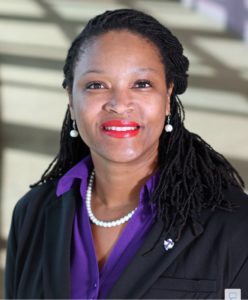FERPA & Social Media: Thoughts for Social Work Education
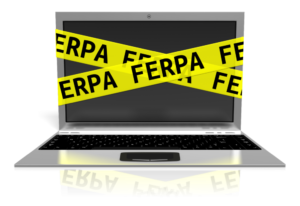 What about FERPA? This is one of the most common questions I hear when presenting about using social media in the classroom. FERPA, the Family Educational Rights and Privacy Act, is the US federal law that protects the privacy of students’ educational record, and ensures that students have some control over their records. Examples of what is included in an educational record at the post-secondary level include grades, transcripts, class lists, student course schedules, and student financial information. Social work educators are often very aware of privacy and disclosure of personally identifiable information because of our practice backgrounds and the NASW Code of Ethics, so FERPA makes sense to us. It is understood that we should abide by FERPA and our professional standards of privacy and informed consent while modelling appropriate ethical standards for our students. However, this does not mean that social media is off-limits as an educational and professional development tool (Drake, 2014). Rather it means that as social work educators, we can use social media with students as long as we do so in ethical and legal ways (Rodriguez, 2011).
What about FERPA? This is one of the most common questions I hear when presenting about using social media in the classroom. FERPA, the Family Educational Rights and Privacy Act, is the US federal law that protects the privacy of students’ educational record, and ensures that students have some control over their records. Examples of what is included in an educational record at the post-secondary level include grades, transcripts, class lists, student course schedules, and student financial information. Social work educators are often very aware of privacy and disclosure of personally identifiable information because of our practice backgrounds and the NASW Code of Ethics, so FERPA makes sense to us. It is understood that we should abide by FERPA and our professional standards of privacy and informed consent while modelling appropriate ethical standards for our students. However, this does not mean that social media is off-limits as an educational and professional development tool (Drake, 2014). Rather it means that as social work educators, we can use social media with students as long as we do so in ethical and legal ways (Rodriguez, 2011).
The purpose of this post is to provide some examples and best practices for FERPA-compliant social media assignments based on my understanding and experiences, and insights from colleagues. As with any ethical challenge, there are no black or white answers, but it is my hope that information in this post will provide insight on how social work educators can embrace the benefits of social media assignments while being mindful of the risks. And there are many benefits to using social media as social workers such as contributing to public conversations, building relationships with other practitioners, and staying current on news and research. Further, helping social work students develop the values and skills to professionally and ethically use social media is included in Council of Social Work Education’s 2015 Educational Policy and Accreditation Standards.
Here are ways I work to ensure that I am being ethical and professional with social media in the classroom:
Harnessing Social Media for Social Good at #CG4SW
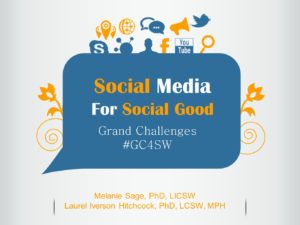 Last week, Melanie Sage and I led a discussion at the Social Work’s Grand Challenge Initiative Conference (#GC4SW) held at the University of Southern California (April 25-28, 2017). We attended the last day of the conference, which focused on for Harnessing Technology for Social Good. If you are not familiar with this challenge, its focus includes leveraging digital and social technologies to enhance, improve, and expand the reach and influence of social services, evidence-based social work practices, and innovative programs. Two white papers outline how social work can use technology to help individuals, communities, and organizations:
Last week, Melanie Sage and I led a discussion at the Social Work’s Grand Challenge Initiative Conference (#GC4SW) held at the University of Southern California (April 25-28, 2017). We attended the last day of the conference, which focused on for Harnessing Technology for Social Good. If you are not familiar with this challenge, its focus includes leveraging digital and social technologies to enhance, improve, and expand the reach and influence of social services, evidence-based social work practices, and innovative programs. Two white papers outline how social work can use technology to help individuals, communities, and organizations:
The use of social media is omnipresent in our daily lives, and ahead of policy and ethics in social work. Technology policy standards typically do not address concerns of social workers, including communication with clients, and professional values of privacy and confidentiality, safety, and self-determination. As a profession, we have few research studies about the use of social media in practice and mixed professional guidance around how to best engage with social media as part of our work with clients, constituents, and communities. Some in social work take a risk-averse approach to social media, limiting how and who they interact with on virtual platforms such as Facebook, Twitter, and Instagram. However, this Grand Challenges supports broader thinking and creativity in how social workers can engage with social media, especially to address the 11 other grand challenges.
As part of our discussion, we proposed that social media can be a tool to help social work academics and practitioners to discover and share knowledge as well as build relationships for collaborative work. Social media platforms are well-placed to allow social workers across the professional continuum to engage with each other, creating communities of learning and practice that bridge the gap between practice and research in social work. We suggested four practices with social media for advancing the Grand Challenges for Social Work:
#BPDNOLA17 – The Social Media Toolkit goes on the road
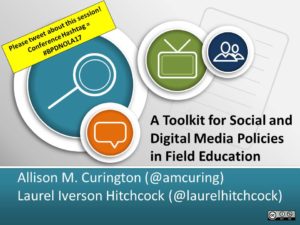 In November 2016, I had the pleasure of presenting with Allison Curington, Director of Field Education at the University of Alabama, about our Social Media Policy Toolkit at CSWE’s 2016 Annual Program Meeting in Atlanta, GA. Today, we are at BPD’s 2017 Annual Conference in New Orleans to share our work once again. We will be talking about a project that we have been working on for the past two years, a Toolkit for Social and Digital Media Policies in Field Education. Please join us at 11:00 AM in Bayside B at the Sheraton in New Orleans for our presentation. Allison and I started collaborating on this toolkit after many, many conversations about the growing use (and misuse) of social media in field education by students, educators and field supervisors. We saw that field directors were increasingly dealing with ethical and practical issues related to the use of social and digital media in field education, and we wanted to provide information and tools to help field directors raise awareness with students and field supervisors.
In November 2016, I had the pleasure of presenting with Allison Curington, Director of Field Education at the University of Alabama, about our Social Media Policy Toolkit at CSWE’s 2016 Annual Program Meeting in Atlanta, GA. Today, we are at BPD’s 2017 Annual Conference in New Orleans to share our work once again. We will be talking about a project that we have been working on for the past two years, a Toolkit for Social and Digital Media Policies in Field Education. Please join us at 11:00 AM in Bayside B at the Sheraton in New Orleans for our presentation. Allison and I started collaborating on this toolkit after many, many conversations about the growing use (and misuse) of social media in field education by students, educators and field supervisors. We saw that field directors were increasingly dealing with ethical and practical issues related to the use of social and digital media in field education, and we wanted to provide information and tools to help field directors raise awareness with students and field supervisors.
Based on feedback from CSWE and a Field Educator’s training at UA in January, we have updated our tools and hope to get even more feedback from our BPD colleagues before launching our toolkit. In our interactive workshop today, we plan to present on the toolkit and share one of the tools from the kit – Social Media Policy Checklist and Worksheet for Social Workers.
#BPDNOLA17 – Road Map for Success: Incorporating Social Media in the Social Work Classroom
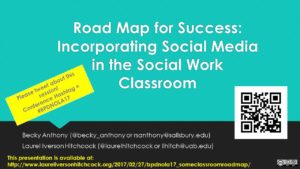 At BPD in 2016, I attended a wonderful session by Drs. Becky Anthony and Jennifer Jewell of Salisbury University titled Building student connection by utilizing social media in the social work classroom. They graciously wrote about this presentation in a blog post – Social Media How-To Guide for Social Work Educators. Today (Saturday, March 4th), Becky and I will be presenting about how we both are the using guidelines that she and Jennifer developed, giving examples from our own teaching and classroom assignments. Please join us at 8:00 AM in Bayside B at the Sheraton in New Orleans for our presentation.
At BPD in 2016, I attended a wonderful session by Drs. Becky Anthony and Jennifer Jewell of Salisbury University titled Building student connection by utilizing social media in the social work classroom. They graciously wrote about this presentation in a blog post – Social Media How-To Guide for Social Work Educators. Today (Saturday, March 4th), Becky and I will be presenting about how we both are the using guidelines that she and Jennifer developed, giving examples from our own teaching and classroom assignments. Please join us at 8:00 AM in Bayside B at the Sheraton in New Orleans for our presentation.
Here is a link to the slides from our presentation: https://www.slideshare.net/laurelhitchcock/bpdnola17-road-map-for-success-incorporating-social-media-in-the-social-work-classroom
Also, information about developing professional social media guidelines for the classroom can be found here.
Here is our abstract with the learning objectives:
Teaching with Infographics: My experiences with digital literacy and non-traditional students
Nathalie P. Jones, PhD, MSW is an Assistant Professor of Social Work at Tarleton State University. In this blog post, Dr. Jones writes about her experiences creating and implementing an infographic assignment with nontraditional social work students.
As an Assistant Professor of Social Work at Tarleton State University, I have absolutely enjoyed educating social work students on the use of technology through macro social work practice courses. I teach a large number of non-traditional learners (those who have been out of school for longer than one year, and are employed, parenting, or in any other roles that are competing with being a learner as defined by the National Center for Education Statistics [2015]). I find that they develop student groups quickly in order to have support while working on assignments, especially those assignments that include the use of digital technology.
To help my students improve their understanding of digital and social technology, I have introduced the use of infographics during an advanced social work course entitled Women’s Issues. Infographics are visual representations of almost any type of information. Infographics are similar to storytelling with visual content and supported with statistical data. They are an effective way to communicate large amounts of information in a clear and succinct way, and are an increasingly popular tool in popular media and the non-profit world (NonProfit Tech for Good, 2014). Understanding how to create, share and evaluate infographics is a key digital literacy skill for social workers (Shelly, 2015). Along with all these benefits, I wanted to create an assignment that was fun and engaging for my nontraditional students who are often nervous about nontraditional, digital assignments.
For the Women’s Issues course, I asked students to research an issue or social problem affecting women, turn that research into an infographic (rather than a written paper), and then share their infographics with professionals outside of the class as a way to network with alliances who advocate on behalf of women. This meant students needed to not only create a quality artifact for a grade, but also learn how to share it with other advocates in a public way – via social media. In an effort to support learners who were experiencing technology in college for the first time, I provided them with seven detailed steps to successfully complete the infographic assignment. These steps involved learning about Twitter as well as creating an infographic.
Here are the assignment steps directly from the course syllabus:
Step 1: Create a Twitter Account & provide your Twitter Handle. *Don’t forget to follow the instructor.
Step 2: Research & provide a resource of two infographics (1) from the web and (1) from Twitter related to Women’s Issues. Then, provide a 1-2 page comparison on how the infographic was distributed, what was learned & why this is a resource for issues related to women.
Modeling Practice: Social Media Guidelines in Social Work Field Education
Last year, I wrote my own profession guidelines for how I use social media in my professional practice as a social work educator. This is often referred to as a Professional Social Media Policy, and is a recommended practice from National Association of Social Workers (NASW, n.d.). Specifically, these guidelines are personal to me, and describe how I strive to interact with students, colleagues and other professionals when using digital and social media. I include these guidelines in my course syllabi and they guide how I use social media to engage students online, disseminate my research, and network with colleagues.
These guidelines came about because of a collaborative project with Allison Curington, Director of Field Education at the University of Alabama. We have been working a toolkit to help social work field educators deal with ethical and practical issues related to the use of social and digital media in field education, focusing on information and tools to help field directors raise awareness with students and field supervisors. As part of this process, Allison also wrote her own professional social media policy. She then decided to ask the entire staff in the UA Office of Field Education to assess their social media use for their own policies. In this interview style post, Allison shares her thoughts about how the process worked and the UA Field Staff developed their own professional social media policies.
How did you write your own policy? How did you approach this process?
Navigating the landscape of technology and social media has been quite the challenge in field education. I can remember when MySpace was all the rage as I was beginning my career as a field director. However, there were very few students in our graduate program who participated on social media platforms. Honestly, we were just trying to navigate not having enough cell phone coverage in rural areas at that time! Fast forward 13 years and you have an entirely new landscape. I would have never dreamed as a field director that I would be dealing with a generation of students who use their primary mode of communication with something other than the phone, e-mail, or even snail mail.

